Are we late with an update? For our latest news, we have brief updates at https://forecast.predictwind.com/tracking/display/SV_TinoPai/
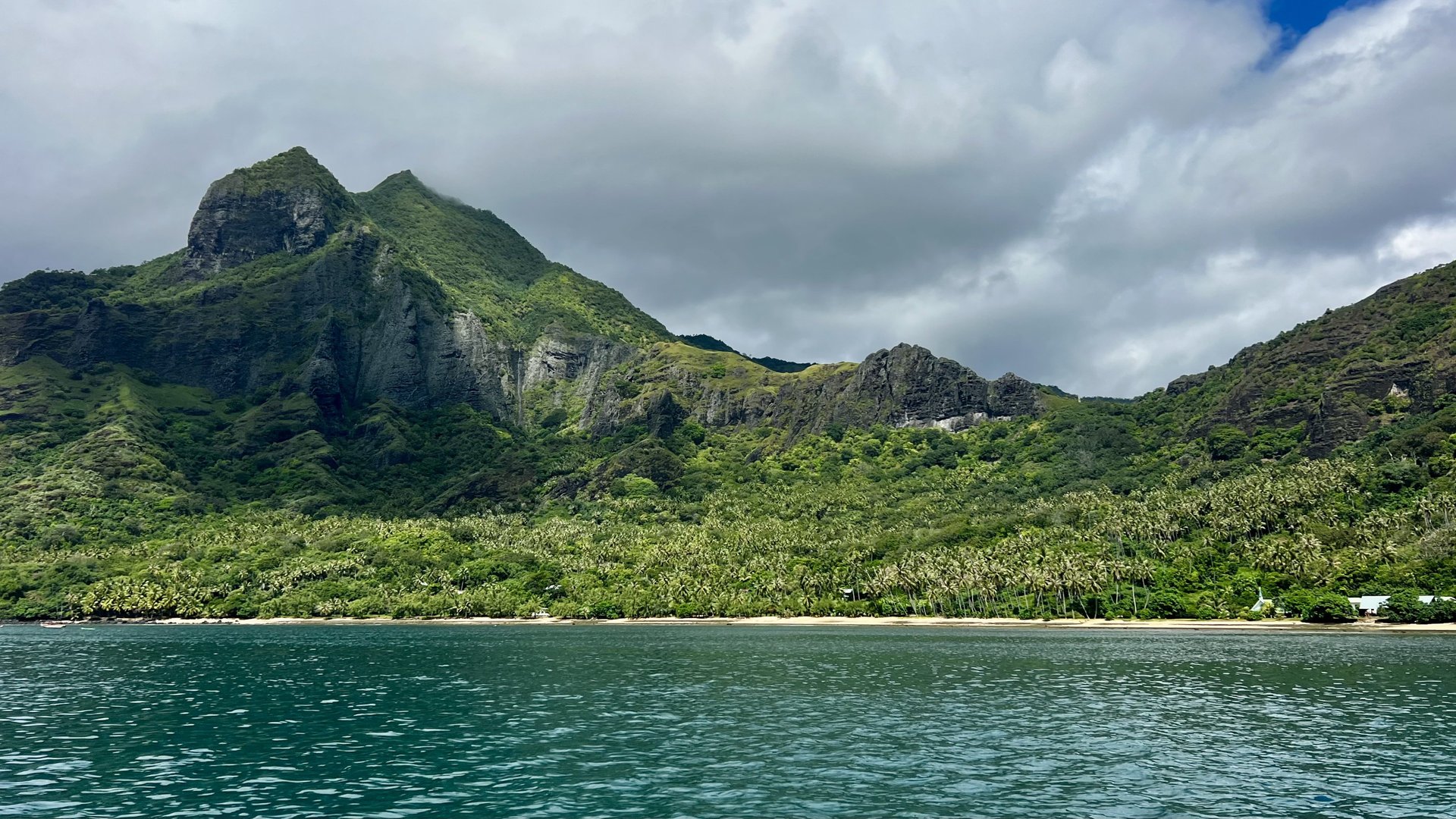
BROKEN DOWN IN ANAHO!
We visit one of the most beautiful bays in the Marquesas, and disaster strikes as our engine is unable to operate...
Andy
7/3/20256 min read
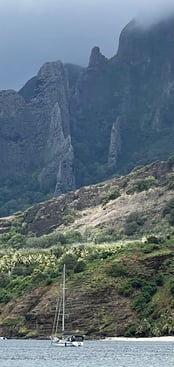

Anaho is a beautiful bay. It’s well sheltered by Marquesan standards, set off by magnificent basalt peaks. While I fancy I can pull a nice description out of the bag occasionally, I can’t compete with Robert Louis Stevenson’s notes from his visit in 1888:
“The cocoa-palm, that giraffe of vegetables, graceful, so ungainly, to the European eye so foreign, was to be seen crowding on the beach, and climbing and fringing the steep sides of mountains. Rude and bare hills embraced the inlet upon either hand; it was enclosed to the landward by a bulk of shattered mountains. In every crevice of that barrier the forest harboured, roosting and nestling there like birds about a ruin; and far above, it greened and roughened the razor edges of the summit.”
Well put, Bob. The sheltered, clear waters of Anaho and the relief it provides from the ever present swell also makes it a great bay to catch up on boat chores while those vegetable giraffes look on. While motoring the last few miles around the eastern point of Nuku Hiva into and into the bay, our engine surging issue had become more noticeable and it was definitely time to do our planned repair. We’d already identified a fuel injector was running cool compared with the other three, and advice from those more knowledgeable than the ship’s engineer indicated this was the likely culprit.
Being handier than I and the owner of a suitable torque wrench, I enlisted Curtis’s help; he dinghied over from Manna and we set to work. Removing the suspect injector we could see some coking which we cleaned out, and after inserting the replacement (we had a spare!) we were confident that we’d solved the problem. And… disaster struck! As we tightened the final banjo bolt on the return fuel rail it sheared through the fuel return hole. And… we didn’t have a spare. This small, hollow bolt is critical as excess fuel passes through it and into the banjo fitting on the return line to the fuel tanks. Without it the engine doesn’t work, full stop. You may insert your favourite expletive here, I did.
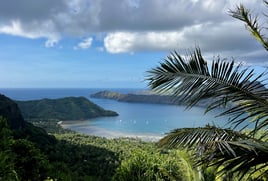

And here we are, dead in the water in a beautiful, mostly calm bay in the middle of the Pacific Ocean, with views of rugged peaks, palm tree lined sandy beaches and warm clear waters. It’s magnificent, and magnificently far from the spare part we need. Our first mission, then, was to find a similar sized bolt with which we could affect a temporary solution; either drilling out its core and a side outlet to mimic the broken part or, more simply, cutting a channel up the side of the bolt to allow fuel to reach the return line. Either could work, we had a plan! Curtis and I searched our own bolt inventory without success. We approached other cruisers, in the anchorage and in the local WhatsApp groups; with no luck, though everyone in this terrific community was happy to sort through their own bolt inventory to check. We then hiked for an hour over the steep ridge to the next bay, Hatiheu, and took an hour-long $200 USD taxi ride to Taiohae, where we’d been informed the small chandlery had one; only to find the size was wrong. Mike from the chandlery then kindly drove us around all the garages in the area but again we had no luck. It seems this bolt - 8M, 1.0 pitch, 16mm long - is an oddity. We were able to find a lot of 8M bolts, however all of them had a 1.25 pitch (1.25mm thread spacing). Even our tap & die set has no 8M/1.0 size, so we couldn’t adapt a larger thread. Almost certain there was nothing on the island that would work, we reached out to a larger store in Papeete to be told there was nothing there either. Merde et putain!
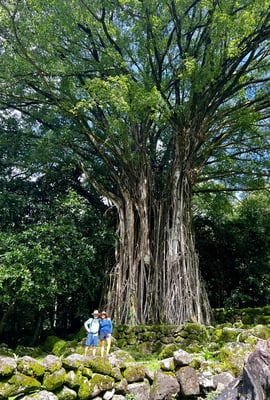

That left the (temporally and literally) longer route of importing the part. Thanks to our internet connection we were able to locate some banjo bolts that had the right specs at Diesel Systems Australia, a diesel specialty supplier in Melbourne. I called them to be sure and a lovely lady called Simone helped us out. We’ve ordered 6 new bolts to replace all the old ones, plus two spares, and they should arrive in Taiohae via FedEx on 5 July, pending import clearance, for less than the taxi ride to Taiohae. Our fingers and toes are crossed! That leaves us filling in time until then in Anaho - ce n’est pas un problème.


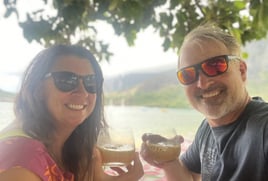

There’s Resturant Kanaho, a great little outdoor eatery ashore that we’ve visited a few times now, it’s necessary to book ahead so they can prepare and every meal has been great. It’s nice to have a break from preparing food and dishes on the boat, and the fact that they make a great cocktail - the “T. Punch”, not skimping on the rum - certainly helps! You have to take whatever the dish of the day is, but they’ve been excellent at ensuring my meals are both gluten-free and delicious.
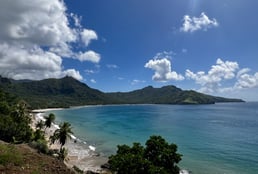

Roger, a local Marquesan, has a garden and orchard nearby from which he sells fruits and vegetables, and Tino Pai’s crew are regular visitors. It’s nice to have fresh lettuce, bell peppers, cucumbers, papaya, bananas and pamplemousse when we want them. Roger is a wiry, sun-worn, cheerful bloke; he speaks a little English, is patient with our rudimentary French, and has taught us a few words of Marquesan. Koutau nui, Roger! Otherwise the homes here are hidden among the trees and, while friendly, the locals keep mostly to themselves.
We’ve taken what remains of the pre-European “ancestor’s road” over the summit to the neighbouring village of Hatiheu a couple of times, once to explore, and as it connects by road with Taiohae, a second time for the taxi in search of our part. Stevenson described the road as “good travelling, but cruelly steep”. It’s still cruelly steep, and in places you can see what remains of the stony paving, but with time much has eroded and the lower aspect on both sides is washed out by rain runoff; constant use by locals with their horses between the villages has created deep, muddy cutouts of gooey clay that weigh down and suck at feet when wet. We’ve learned to wait for drier days when taking the path. It takes a sweaty hour through the jungle between the villages, allowing for a short stop to pick wild mangoes and admire the summit view.
Hatiheu is another nice village with a restaurant and a couple of small stores, and a sheltered anchorage that we’ll certainly visit for longer once we’ve got the engine fixed. We rewarded ourselves for the strenuous hike over with lunch and drinks at Chez Yvonne, feeding our leftovers to the large blue-eyed eels in the creek next to the restaurant. They seemed to appear from nowhere, and thrashed about in the water - and occasionally out of it - as they fought for the scraps.
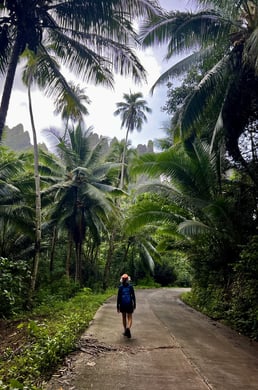

There are enormous basalt spires at the western side of the bay, and during our exploration we were able to scramble around two excellent large areas of ruins just outside of town, complete with real ancient tikis. I’ve developed a fascination for these ruins and tikis - the original ones, not those carved more recently - which maybe I’ll expand on sometime. They offer a glimpse into a much more populous, obviously ferocious and sometimes gruesome past. The larger of the two ruins had hut structures added showing how the paepae must have looked when occupied, and an enormous Banyan tree, the sacred tree of the ancients, that to us looked like something out of Avatar. We were dwarfed and astonished by it.
Otherwise, we’ve been snorkeling the reef that circles the bay to landward, and exploring the windswept beach east of Anaho accessible by only by trail. There are mantas here too, and we’ve had some lovely moments swimming with them, as well as spotting turtles, eagle rays, and black tipped sharks among the myriad fish species. There are certainly lots of fish on the reefs here, which has a lot to do with the prevalence of ciguatera in reef fish, a neurotoxin that, while harmless to the fish themselves, is dangerous to people who might eat the fish. Regrettably, that means we’ll not be spearfishing while in French Polynesia. And so, we wait and enjoy the area. We hope that the next installment has Tino Pai up and running again. Jusque là!
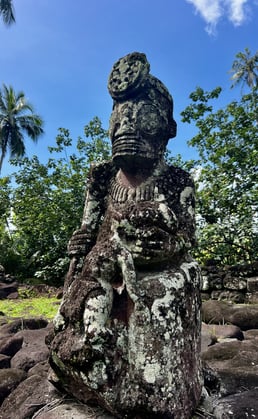



The best way to contact us is in the comments section of our social media sites (see links). These pages are for those of you who, as we do, sometimes enjoy an old-school website! So Gen-X. All of the information on the site is for entertainment only and must not be copied without permission, including our logo. Thanks, and enjoy the website!



